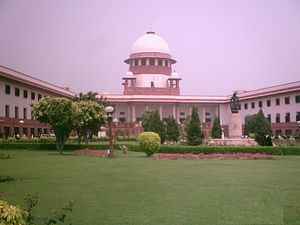The spotlight has remained firmly fixed on India’s legal system over the past few weeks. First came the accusation that a retired Supreme Court judge had sexually harassed an intern, followed by the Supreme Court’s reinstatement of Article 377 of India’s penal code, an anachronistic provision that bans gay sex. Figures on the chronic backlog of court cases, released last week, are a further indictment of the country’s beleaguered legal system.
Four years ago India’s Prime Minister, Manmohan Singh, informed the Lok Sabha (the lower house) that India had the largest backlog of cases in the world, and figures from this year estimate that as many as 30 million cases are pending. The Hindustan Times reported last week that over four million of these are High Court cases, with a further 65,000 cases pending in India’s Supreme Court.
According to Markandey Katju, a retired Supreme Court justice, judges should have no more than 300 cases pending at any one time, but backlogs for individual judges stretch into the tens of thousands. In 2009, the Chief Justice of the New Delhi High Court released a damning report in which he claimed it would take 466 years for the court to clear its backlog. Despite spending on average less than five minutes per case, in 2009 the court had 600 cases that had been lodged over 20 years ago.
The implications are serious. Due to the backlog, most of India’s prison population are detainees awaiting trial. Courts in Mumbai, India’s financial hub, are clogged with decade-old land disputes, hindering the city’s industrial development. And the pursuit of justice, ordinarily a costly endeavor, has only been made more expensive by chronic delays. As a result, India’s legal system has increasingly become the preserve of the country’s wealthy and well connected – a development that exacerbates the discrimination already faced by India’s minority and low-caste groups.
In the last few years in particular, successive Ministers for Law and Justice have taken on the job promising urgent reforms. Ashwani Kumar said, when taking office in 2012, that addressing the backlog was necessary to maintain India’s “constitutional democracy,” to adhere to “the rule of law” and to “guarantee order and stability in society.” But despite the scale of the problem, little has been achieved. Kapil Sibal, who took on the Law and Justice portfolio in May of this year, similarly pledged “radical structural reforms.”
In 2008 India’s government set itself the target of having 50 serving judges per million people by 2013. Last year, when it became clear that India was far short of this goal, a less ambitious 5-year plan was announced: a doubling of the number of judges in “subordinate” courts (excluding High Courts and the Supreme Court). India’s current ratio stands at less than 15 judges per million, and even if the new target were achieved, India would still be nowhere near the United States, for example, where there are over 100 judges per million.
India’s federal structure is part of the problem. The responsibility of dispensing justice is split between New Delhi and the states, and the latter are responsible for employing and paying new judges. In addition to judicial shortages, courts are desperately underfunded. Kapil Sibal further promised to overhaul the “opaque” process of judicial appointment, promising a “transparent” process based on “integrity” and “competence.” These structural reforms are both urgent and necessary, but few have hopes of things changing soon. As Jagdish Verma, a retired Supreme Court judge, complains, even elementary measures, such as longer court sittings and more working days, have yet to be implemented.
These reforms nonwithstanding, inefficiency and corruption remain the biggest problems. Advocates and court administrators routinely try to fix trials by bribing judges or intimidating witnesses. Much of the corruption is covert. Refusing to register cases for the violation of strict formalities – incorrectly spaced legal documents, for example – is one of the many ways in which the process of administering justice is frustrated.
There are some signs of progress: an All India Judicial Service is being considered to improve the quality of subordinate judges, reforms to legal procedure have limited the number of adjournments in civil and criminal cases, the number of cases pending due to “bounced cheques” – another corrupt trick – is down, and since being set up by the federal government in 2001 over 1000 “fast track” courts have disposed of more than three million cases.
The multi-pronged reforms are a long-term project and judges will first have to be brought on board with any significant changes to their profession. Until then, the backlog continues to erode trust in India’s legal system, the status of India’s judiciary and faith in the rule of law. Part of the outrage that followed last year’s horrific Delhi gang rape case stemmed from the fact that the law had failed to deter offenders. Fast-track courts, dedicated to cases of sexual crimes, were opened across the country to address this sentencing and trust deficit. But speedy justice presents its own challenges.
Certainly “justice delayed is justice denied” but the opposite, that “swift justice is injustice,” is also true. Though fast track courts have whittled away India’s backlog, judges and observers have raised concerns about the quality of justice being administered.

































